
This edition of TR News focused on railroad trespassing solutions, and featured work from Rutgers CAIT as well as other researchers. Photo ©TR News.
CAIT-affiliated researchers were featured in a recently-released issue of TR News for their work deploying artificial intelligence to help detect and analyze railroad trespassing events, utilizing an innovative solution to address one of the biggest challenges faced by the industry today.
By using a customized Artificial Intelligence (AI) algorithm for automated trespassing detection based on big-video data, researchers at Rutgers Center for Advanced Infrastructure and Transportation (CAIT) were able to compile large data sets in real-time that provide insights into trespassing behavior.
Led by Dr. Xiang Liu, lead of the Rail and Transit Program and an assistant professor in Transportation Engineering at Rutgers, as well as graduate research assistants Asim Zaman and Baozhang Ren, the goal of the research was to ultimately support and better inform risk-mitigation decisions and address trespassing behavior and issues.
The work was featured in a recent edition of TR News that focused on railroad trespassing solutions. The individual article can also be found here.
Between 2009 and 2016, railroad property trespassing and grade-crossing collisions were responsible for 95 percent of all railroad deaths on freight and passenger railroads. This makes it one of the biggest problems in the industry today, and especially prominent in a densely populated state such as New Jersey, and along the heavily-traveled Northeast Corridor.
However, many instances of trespassing still go undetected. This is often because most rail-trespassing behavior does not result in injuries or fatalities. This has created a lack of data that has made it hard to analyze and learn from trespassing events.
Collecting and analyzing camera-video data for railroad trespassing has also traditionally been a laborious and time-intensive process. But, by using AI and the existing video infrastructure at railroads, researchers found a way to watch for, recognize, and understand trespassing events in real time.
“With this AI technology, it is possible to compile large data sets of trespassing events and provide useful insights into trespassing behavior to ultimately support risk mitigation decisions,” said Dr. Liu. “Learning from trespassing is a critical element of effectively developing education, enforcement, and engineering strategies that enhance safety and prevent future trespassing on railroad tracks.”

